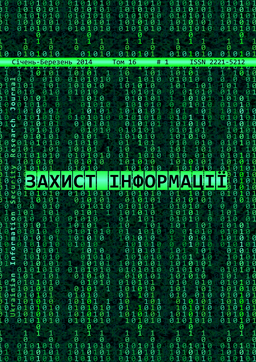Methodology for the selection of design solutions for the deployment of secure lte network
DOI:
https://doi.org/10.18372/2410-7840.16.6315Keywords:
cellular networks, base station, LTE, choice of matrix solution, project, user requirements, architecture decisionsAbstract
To maintain high-speed applications, the use of new services , support continuous mobile access to the Internet telecom operators need to develop plans for the implementation of new technologies and update existing business communications with the general trend of scientific and technological innovation and development. Strong demand in the market of communication services is offset by the presence of even greater demand. Often the customer telecommunication solutions to the huge amount offered him a variety of services for which prices vary by orders of magnitude is unable to make the right choice. It is based on this position you must offer a technique whose purpose will be to harmonize consumer requests to the communication system based on packet data through the channels of modern mobile communication systems fourth generation. The paper presents a step by step methodology for selecting design solution for TTE network deployment, taking into account the need to protect information. The basic user requirements to next generation networks and analyzes how they affect the selection of equipment for the construction of the network. A reasonable description and selection decision matrix, based on which the final result is the choice of design solution, according to the requirements of users.References
Вишневский В. М. Энциклопедия WiMAX: Путь к 4G / В. М. Вишневский , С. Л. Портной, И. В. Шахнович — М. : Техносфера, 2009. — 472 с.
Одарченко Р. С. Аналіз перспектив технології WiMAX в Україні / Р. С. Одарченко, Ю. О. Петрова // Політ-2011. Сучасні проблеми науки : міжнародна науково-практична конференція мо-лодих учених і студентів, 7—9 квітня 2010 р. : тези доп. — К. : НАУ, 2011. — С. 29.
Перспективи та рекомендації по впровадженню стільникового зв’язку 4-го покоління / В. В. Ткаченко, Р. С. Одарченко, В. С. Повхліб, Т. Р. Андрійченко // Проблеми навігації та управління рухом : Всеукраїнська науково- практична конференція молодих учених і студентів; м. Київ, 21—22 листопада 2011 р. : тези доповідей / редкол. : М. С. Кулик та ін. — К. : НАУ, 2011. — С. 122.
Тихвинский В. О. Сети мобильной связи LTE: технологии и архитектура / В. О. Тихвинский, С. В. Терентьев, А. Б. Юрчук. — М. : Эко-Трендз, 2010. — 284 с.: илл.
Ткаченко В. В. Вітчизняні перспективи розвитку технології LTE / В. В. Ткаченко, І. О. Дударчук, К. В. Дружиніна // Проблеми навігації та управління рухом : Всеукраїнська науково-практична конференція молодих учених і студентів; м. Київ, 23—24 листопада 2010 р. : тези доповідей / редкол. : М.С. Кулик та ін. — К. : НАУ, 2010. — С. 105.
Ткаченко В. В. Методи прогнозування попиту на послуги мереж LTE / В.В. Ткаченко, Р. С. Одарченко, Ю. О. Петрова // Політ-2011. Сучасні проблеми науки : міжнародна науково-практична конференція молодих учених і студентів, 7—9 квітня 2010 р.: тези доп. — К. : НАУ, 2011. — С. 30.
Конахович Г.Ф. Аналіз залежності кількості абонентів стільникових мереж від доходів населення / Г.Ф. Конахович, І. О. Козлюк, В. В. Ткаченко, Р. С. Одарченко // Наукоємні технології. — 2012. — №. 3 (15). — С. 48—51.
Тихвинский В.О., Терентьев С.В. Управление и качество услуг в сетях GPRS/UMTS. — М.: Эко-Трендз, — 2007. — 400 с.
V. Vyshnevskyy, S. Portnoy, I. Shakhnovich, Encyclopedia WiMAX: Road to 4G, Moscow: Techno¬sphere, 2009, 472 p.
R. Odarchenko Analysis of the prospects for WiMAX technology in Ukraine Flight 2011. Challenges of Science: International Scientific and Practical Conference of Young Scientists and Students, April 7-9, 2010: Abstracts ext, K.: NAU, 2011, P. 29.
V. Tkachenko, R. Odarchenko, V. Povhlib, T. Andriychenko Perspectives and recommendations on the introduction of cellular 4th Generation, Issues Navigation and Traffic Management, National Scien-tific Conference young scientists and students, Kyiv, November 21-22, 2011: abstractsredkol. MS Kulik et al., K.: NAU, 2011, P. 122.
V. Tikhvinsky Sets mobylnoy connection TTE: Technology and Architecture / V. Tikhvinsky , S. Teren- tev, A. Yurchuk, Moscow: Eco-Trendz, 2010, 284 p.
V. Tkachenko Domestic perspectives of technology TTE / V. Tkachenko , I. Dudarchuk , K. Druzhynina, Issues Navigation and Motion Control: National Sci-entific Conference of young scientists and students, Kyiv, 23-24 November 2010: abstracts/redkol: MS Kulik et al., K.: NAU, 2010, P 105.
V. Tkachenko Methods of forecasting demand for network TTE / V. Tkachenko, R. Odarchenko, Y. Petrova, Flight 2011. Challenges of Science : Interna-tional Scientific and Practical Conference of Young Scientists and Students, April 7-9, 2010: Abstracts ext, K.: NAU, 2011, P. 30.
G. Konahovich Analysis of the number of subscribers of cellular networks on income / G. Konahovich, I. Kozlyuk, V.Tkachenko, R. Odarchenko, science-intensive technology, 2012, №. 3 (15), P. 48-51.
V. Tikhvinsky, S. Terentev The quality of services and Management in setyah GPRS/UMTS, Moscow: Eco-Trendz, 2007, 400 p.
Downloads
Issue
Section
License
Authors who publish with this journal agree to the following terms:- Authors retain copyright and grant the journal right of first publication with the work simultaneously licensed under a Creative Commons Attribution License that allows others to share the work with an acknowledgement of the work's authorship and initial publication in this journal.
- Authors are able to enter into separate, additional contractual arrangements for the non-exclusive distribution of the journal's published version of the work (e.g., post it to an institutional repository or publish it in a book), with an acknowledgement of its initial publication in this journal.
- Authors are permitted and encouraged to post their work online (e.g., in institutional repositories or on their website) prior to and during the submission process, as it can lead to productive exchanges, as well as earlier and greater citation of published work (See The Effect of Open Access).

